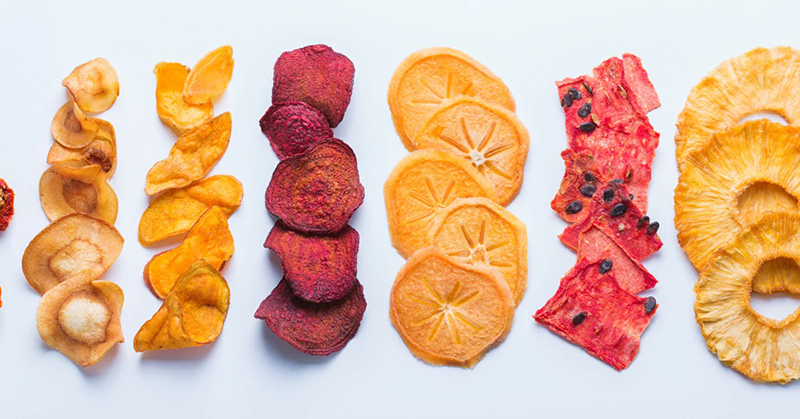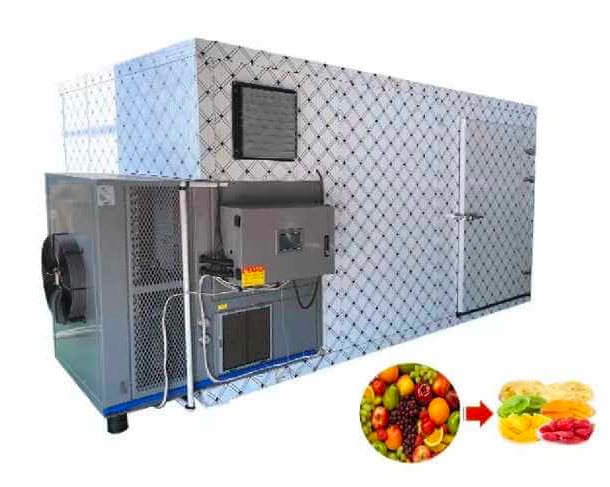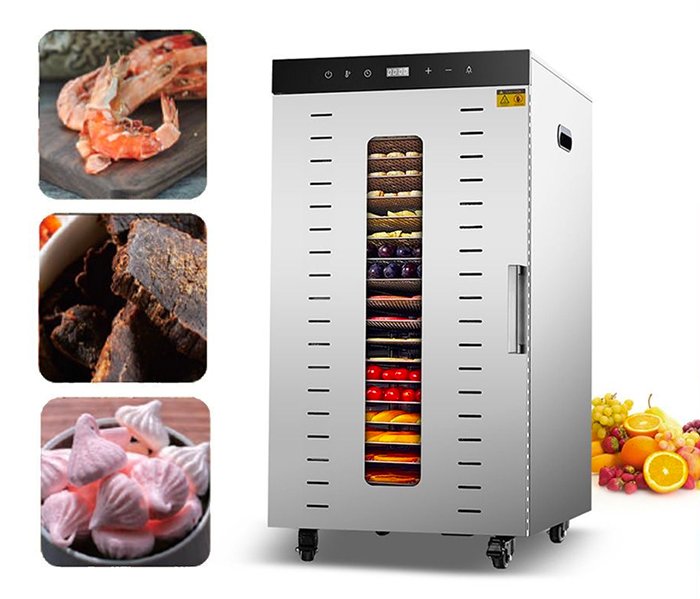
Content Menu
● Understanding Food Drying Machines
>> Heat Pump Dryers
>> Vented Dryers
● Comparison Table: Heat Pump vs. Vented Dryers
● Benefits of Using Food Drying Machines
● Working Principle of Food Drying Machines
● Types of Food Suitable for Dehydration
● Factors Influencing Drying Time
● Energy Consumption Comparison
● Maintenance Tips for Food Dryers
● Innovations in Food Drying Technology
● Conclusion
● FAQ
>> 1. What types of foods can be dried using a heat pump dryer?
>> 2. How long does it take to dry food using these machines?
>> 3. Are heat pump dryers more expensive than vented dryers?
>> 4. Can I use a vented dryer indoors?
>> 5. How do I maintain my food dehydrator?
● Citations:
Food dehydration is a crucial process in food preservation, enhancing shelf life, and maintaining nutritional value. In this article, we will explore the various types of food drying machines available, focusing on the differences between heat pump and vented dryers, their applications, and benefits in the food industry.

Understanding Food Drying Machines
Food drying machines are designed to remove moisture from food products, thereby preventing spoilage and extending shelf life. These machines utilize different technologies and methods for drying, with heat pump and vented dryers being two popular options.
Heat Pump Dryers
Heat pump dryers utilize a closed-loop system that captures and recycles hot air. This technology is energy-efficient because it reuses the heat generated during the drying process.
Key Features:
- Energy Efficiency: Heat pumps can achieve thermal efficiencies of up to 70%, reducing energy costs significantly.
- Temperature Control: They operate at lower temperatures (typically between 50°C to 65°C), which helps preserve the nutritional quality of the food.
- Moisture Control: The system maintains optimal humidity levels within the drying chamber, ensuring uniform drying without overheating.
- Versatility: Suitable for a wide range of products including fruits, vegetables, herbs, and meats.
Applications:
Heat pump dryers are ideal for commercial applications where energy costs are a concern and high-quality output is required. They are widely used in industries focusing on organic and natural food products.
Vented Dryers
Vented dryers operate by expelling hot, moist air outside through a vent. This traditional method is simple but less energy-efficient compared to heat pump dryers.
Key Features:
- Direct Airflow: Hot air is blown into the drying chamber where it absorbs moisture from the food before being vented out.
- Higher Temperatures: Vented dryers typically operate at higher temperatures (up to 140°C), which can lead to faster drying times but may also degrade some nutrients.
- Simplicity: These machines are generally easier to install and maintain due to their straightforward design.
Applications:
Vented dryers are often used in smaller operations or where space for venting is available. They are suitable for drying bulk items quickly but may not be ideal for high-quality or sensitive products.
Comparison Table: Heat Pump vs. Vented Dryers
| Feature | Heat Pump Dryer | Vented Dryer |
| Energy Efficiency | High (up to 70%) | Low |
| Temperature Control | Low temperatures (50°C - 65°C) | High temperatures (up to 140°C) |
| Moisture Control | Recycles moisture | Expels moisture |
| Nutritional Preservation | High | Moderate |
| Installation Complexity | Moderate | Simple |
| Typical Applications | Organic foods, herbs, meats | Bulk items, quick drying |
Benefits of Using Food Drying Machines
Food drying machines offer numerous advantages that enhance food preservation processes:
- Nutrient Preservation: Dehydration retains vitamins and minerals better than other preservation methods like canning or freezing.
- Long Shelf Life: Dried foods have significantly extended shelf lives, making them ideal for storage and emergency supplies.
- Cost-Effective: Purchasing seasonal produce in bulk and dehydrating it can reduce overall food costs.
- Healthy Snacking Options: Dried fruits and vegetables serve as nutritious snacks without preservatives or added sugars.
- Versatility in Use: Food dehydrators can be used for various products beyond fruits and vegetables, including herbs, jerky, and pet treats.

Working Principle of Food Drying Machines
The working principle behind most food dehydrators involves several key components:
1. Heating Element: Provides the necessary heat to evaporate moisture from the food.
2. Fan System: Circulates warm air throughout the drying chamber to ensure even distribution of heat.
3. Trays or Racks: Food is placed on trays that allow air circulation around each piece, facilitating uniform drying.
4. Control Systems: Modern machines come with adjustable temperature settings and timers for customized dehydration processes.
Types of Food Suitable for Dehydration
Understanding which foods can be effectively dried is essential for maximizing the utility of your dehydrator. Here's a breakdown of common foods that can be dried using both heat pump and vented dryers:
- Fruits: Apples, bananas, strawberries, mangoes, and apricots are popular choices. These fruits retain their flavor and nutrients when dried properly.
- Vegetables: Carrots, tomatoes, bell peppers, and zucchini can be dehydrated to enhance their shelf life while maintaining their taste.
- Herbs: Basil, thyme, oregano, and parsley dry well and can be stored for use in cooking throughout the year.
- Meats: Jerky is a popular dried meat product that can be made from beef, turkey, or chicken using either type of dryer.
- Nuts and Seeds: While not typically dehydrated in the same way as fruits or vegetables, nuts can benefit from low-temperature drying to enhance flavor without roasting them.
Factors Influencing Drying Time
Several factors influence how long it takes to dehydrate food effectively:
- Moisture Content: Foods with higher moisture content will take longer to dry than those with lower moisture levels.
- Thickness of Slices: Thicker slices require more time compared to thinner ones due to reduced surface area exposure to heat.
- Temperature Settings: Higher temperatures may speed up the process but could also lead to nutrient loss or uneven drying.
- Airflow Circulation: Proper airflow ensures that moisture is efficiently removed; inadequate circulation may extend drying time significantly.
Energy Consumption Comparison
When considering energy consumption between heat pump and vented dryers:
- Heat pump dryers tend to use less energy over time due to their efficient recycling of hot air. Although they may have a higher upfront cost, their operational costs are generally lower because they consume less electricity per batch dried.
- Vented dryers often require more energy due to continuous heating cycles needed to replace expelled hot air with fresh air. This can lead to higher electricity bills if used frequently in commercial settings where large quantities of food need to be dried quickly.
Maintenance Tips for Food Dryers
Proper maintenance ensures longevity and efficiency in food dehydrators:
1. Regular Cleaning: After each use, clean trays with warm soapy water. Avoid abrasive materials that could scratch surfaces.
2. Check Seals and Gaskets: Ensure that seals are intact for heat pump dryers; damaged seals can lead to inefficiencies.
3. Inspect Fan Systems: Regularly check fans for dust accumulation or obstructions that could hinder airflow.
4. Follow Manufacturer Guidelines: Adhere strictly to maintenance schedules provided by manufacturers for optimal performance.
Innovations in Food Drying Technology
Recent advancements in technology have led to more efficient food drying solutions:
- Smart Dehydrators: Modern units come equipped with Wi-Fi connectivity allowing users to monitor progress remotely via smartphones or tablets.
- Multi-functional Units: Some machines now combine dehydration with other functions such as fermentation or yogurt-making capabilities.
- Improved Insulation Materials: Enhanced insulation reduces energy loss during operation leading to even greater efficiency in heat pump models.
Conclusion
In summary, both heat pump and vented dryers play crucial roles in food dehydration processes. Heat pump dryers offer greater energy efficiency and better nutrient preservation at lower temperatures, making them suitable for high-quality food production. On the other hand, vented dryers provide a simpler solution for quicker drying tasks but may compromise on energy use and nutritional retention.
Choosing the right type of dryer depends on specific needs such as product type, desired quality, energy considerations, and operational scale. As technology continues to evolve in this field, both commercial producers and home users will benefit from improved efficiency and versatility in food dehydration methods.

FAQ
1. What types of foods can be dried using a heat pump dryer?
Heat pump dryers are versatile and can dry a wide range of foods including fruits, vegetables, herbs, meats, and even flowers.
2. How long does it take to dry food using these machines?
Drying times vary based on the type of food and moisture content but typically range from several hours to over a day for bulk items.
3. Are heat pump dryers more expensive than vented dryers?
Yes, heat pump dryers generally have a higher initial cost due to their advanced technology but offer savings in energy costs over time.
4. Can I use a vented dryer indoors?
No, vented dryers require an outlet to expel moist air outside; therefore they are not suitable for indoor use without proper ventilation systems.
5. How do I maintain my food dehydrator?
Regular maintenance includes cleaning trays after each use, checking seals for wear, ensuring fans are functioning properly, and following manufacturer guidelines for servicing.
Citations:
[1] https://www.tondefoodmachine.com/drying-machine/electric-food-dryer-machine.html
[2] https://airtekdehydrator.com/types-commercial-food-dehydrators/
[3] https://www.webmd.com/diet/dehydrating-food-good-for-you
[4] https://www.homeserve.co.uk/knowledge-hub/energy-saving-advice/vented-vs-condenser-vs-heat-pump/
[5] https://www.hbh-woolacotts.co.uk/blog/2022/vented-vs-condenser-vs-heat-pump-tumble-dryers-what-are-the-running-costs/
[6] https://www.ike.cn/ike-industrial-commercial-food-dryer-machine-easy-installation-for-food
[7] https://www.youtube.com/watch?v=lEUA2t2XD5M
[8] https://www.alamy.com/stock-photo/sun-drying-food.html
[9] https://www.ike.cn/fruit-and-vegetable-dryer-machine-dehydrator-for-herbs-ike
[10] https://www.istockphoto.com/photos/food-dehydrator











